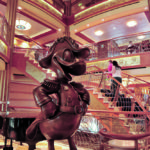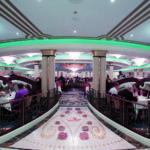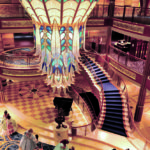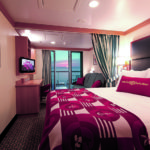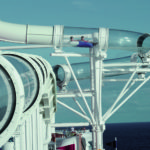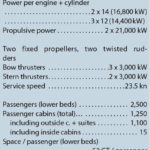Klaus Nienaber
With a dash of Disney magic and a surprising twist, a helicopter hoisted a nearly 5 m[ds_preview] high »champagne bottle« across the bow of Disney Cruise Line’s youngest newbuilding – German Meyer Werft’s hull no. 687 – and officially named the vessel »Disney Dream« (130,000 GT) during a christening ceremony in Port Canaveral, Florida, USA, in the morning of January 19, 2011, welcoming the youngest member of the company family.
Serving the traditional role of godmother for the »Disney Dream« christening was Jennifer Hudson, the Academy Award and Grammy Award winner whose own dreams of stardom began when she was a performer on the »Disney Wonder« (85,000 GT) in 2003. Hudson was joined onstage by Disney CEO Bob Iger and Walt Disney Parks & Resorts Chairman Tom Staggs, as the enormous »champagne bottle« filled with dreams of adventure, romance and fun was lifted into the air and broken across the bow of the new ship.
Naming »Disney Dream«
Some 3,000 people where gathered at the new family resort vessel for the christening ceremony including celebrities, media and members of the public. The spectacle befitted a ship brimming with innovative »wows« – including gallery art that comes alive, the first water coaster aboard a cruise ship, »Magical Portholes« that provide inside staterooms with a real-time ocean view, a full-blown shipboard fireworks, personal interaction with animated characters, play floors like gigantic video games, and original Broadway-style stage spectaculars.
»For over a decade, Disney Cruise Line has been making vacation dreams come true for millions of families and we continue that tradition with the launch of this ›Disney Dream‹ today«, Bob Iger explained proudly. »The mix of imagination and innovation found on ›Disney Dream‹ is unparalleled and elevates the family cruise experience to new heights«.
First voyages
On January 26, the 4,000 passenger accommodating »Disney Dream« sailed out of Port Canaveral for her maiden voyage. She joins the »Disney Magic« and »Disney Wonder« – each carrying 2,700 passengers and built by Italian Fincantieri Group in 1998/1999 – as first of two newbuildings contracted with German Meyer Werft. »Disney Fantasy« (Meyer’s hull no. 688) is to join the fleet in 2012.
»The addition of the ›Disney Dream‹ provides an opportunity to extend our horizons and open up Disney cruising to more families«, Tom Staggs said. »From the majestic beauty of Alaska, to the culture and history of Europe, to the fun and sun of the Caribbean, families looking to take a Disney cruise have more options than ever before.«
In 2011, »Disney Dream« will sail three-, four- and five-night itineraries to the Bahamas and Disney’s private island, Castaway Cay. »Disney Magic« will sail seven-night Eastern and Western Caribbean itineraries and seven-, ten- and eleven-night European cruises out of Barcelona during the summer months. »Disney Wonder« will sail seven-night Mexican Riviera cruises from Port of Los Angeles beginning January 23 and seven-night Alaska itineraries from Vancouver, British Columbia, Canada, during summer months.
Disney Cruise Line
Disney Cruise Line is an American cruise line company owned and operated by Walt Disney Parks and Resorts, a division of The Walt Disney Company, founded in 1923 by Walt Disney (*1901 in Chicago, †1966 in Burbank, California). He created numerous animated cartoons around Mickey Mouse and its various colleagues becoming the company’s trademark. Out of the film and cartoon activities the Disney Park and Resort business was established. Disney Cruise Line was created in 1995, when the company commissioned two new family resort cruise ships according to completely own designs at Italian Fincantieri shipyards. Herewith the company ended arrangements with Premier Cruise Line for the maritime segment of its vacation packages.
Today, the company operates three large resort ships – four by 2012. These are the first cruise ships since the 1950s to be built with two funnels, catering to loyal Disney followers: everything aboard the ships is Disney – every song, every piece of artwork, every movie and production show, and Mickey’s ears adorn the ships’ funnels. But there are no casinos on board and no library. However, its »rotation dining« concept proves to be completely Disney-logical: together with one’s waiter one moves to each of three identically-sized restaurants – each with different décor – in turn.
Disney is all about families with children, and the ships cater both. One can buy a package combining a short stay at a Disney resort with a cruise. Disney has its own cruise terminal at Port Canaveral, Florida, its design being a close copy of the Ocean Terminal in Southampton, UK, used by yesteryear’s ocean liners.
Based in Celebration, Florida, Disney Cruise Line experience is focused on providing a setting where families can reconnect, adults can recharge and kids can immerse themselves in worlds of fantasy only Disney can create. Most recently, the company was recognized as the top cruise experience by the readers of »Conde Nast Traveler« magazine. Disney Cruise Line was voted the No. 1 cruise experience in the magazine’s 2010 Readers’ Choice Awards in the mega-ship category.
There is more fun and recreation for guests of all ages during daylong visits to »Castaway Cay«, Disney’s private 1,000-acre Bahamian island paradise. Designed with areas and activities for every age group, the island provides an authentic tropical experience for everyone. With crystal-clear turquoise waters as far as the eye can see, powdery white sandy beaches, swaying palm trees, an authentic island barbecue and plenty of snorkelling and water sports, »Castaway cay« provides the ultimate escape, whether its adventure, relaxation or quality time with the family.
Most recently, the company announced enhancements to the island designed to deliver an even greater guest experience and to prepare for the arrival of the new Disney ships, currently put into service or are under construction. Enhancements include extended beaches, private beach cabanas, a new teen hang-out and new water play features including a floating play structure set in the Castaway lagoon complete with two water slides.
Meyer’s delivery of »Disney Dream«
Disney Cruise Line took possession of its newest ship – »Disney Dream« – on December 9, 2010, from German Meyer Werft in a traditional maritime ceremony aboard the newbuilding in Bremerhaven. The yard’s flag was lowered while the new owner’s flag was raised, transferring ownership from the shipbuilder to Disney. This fundamental milestone closed the book on the ship’s construction journey which began nearly two years ago in Papenburg, Germany, and signalled her readiness to welcome guests on her maiden voyage, which started on January 26 this year from Port Canaveral.
Meyer Werft and Disney Cruise Line first signed the contract to build two new ships in April 2007. Shortly thereafter, planning for the design of the ships began and construction started with the first steel cutting in Papenburg on March 2, 2009. Since the recent completion of the vessel’s float-out from the shipyard and conveyance along the river Ems, the test-and-adjust period was fulfilled, including sea trials and a brief dry docking in Hamburg. The delivered ship remained in Bremerhaven for another week while additional crew members boarded, and supplies and provisions were loaded. Before Christmas »Disney Dream« left the German coast for her transatlantic voyage to the USA.
The vessel with nearly 340 m length, 37 m width and 8.32 m draft has two traditional funnels on top of 18 decks (including 4 technical decks) high superstructure. The hull is shaped as an extreme clipper-bow above waterline and a bulbous bow under water. The stern is formed incident forward as a traditional cruiser-stern. Like her forerunners, »Disney Dream« continues the Disney Cruise Line tradition of blending the elegant grace of early 20th century transatlantic ocean liners with contemporary design to create one of the most stylish and spectacular cruise ships afloat.
»The 1930s time of travel was the most romantic, so that is where we started with our design«, explained Bruce Vaughn, chief creative executive for Walt Disney Imagineering. »We want our guests to get excited just seeing the ship – evoking a beautiful, classic 1930s ocean liner«.
Signature design
Distinguished by gracefully sweeping lines and meticulous details, the »Disney Dream« celebrates sea travel with unmistakeable Disney touches. The ship’s exterior colour scheme matches the iconic Mickey Mouse with a black hull, bold red funnels and vivid yellow striping and lifeboats. Small touches, such as silhouettes of Disney characters scrolled into the cruise line’s signature yellow filigree ornamentation that stretches from bow to stern, are subtle reminders that this is one of the most magical ships at sea.
Carrying the modern classic design inside, the elegant interior décor on »Disney Dream« is influenced by the Art Deco style with »a dash of Disney whimsy«, Bruce Vaughn said. »We are about taking families on vacation and immersing them in stories. We want to transport them out of everyday reality to a different reality«.
»Atrium Lobby«
For guests sailing on »Disney Dream« that »different reality« begins in the magnificent three-deck high atrium lobby. Reminiscent of splendid ocean liners from the 1920s and 1930s, the stylish sophistication of the atrium is highlighted by sweeping grand staircases, oversized portholes and stunning, three-story fluted columns with glowing capitals. An exquisite marble floor inlaid with an intricate »Art Deco« pattern and hand-tufted custom rugs in rich blue, red and gold colours span the atrium floor and staircase.
Decorative bronze friezes featuring Disney characters line the balconies, and a keen eye may notice Disney characters in the bronze balustrade rising up the grand staircase. Panoramic elevator columns that face into the atrium feature elaborate metal work crafted in an »Art Deco« pattern with a hint of a familiar Mickey Mouse outline.
Opulent furnishings complement the atrium design, with a grand piano providing atmosphere. Original art work in bronze, bas relief and tile mosaics add elegance. An »Art Deco« inspired chandelier, about 6.7 m wide and descending a story-and-a-half down from the ceiling, sparkles with thousands of hand-crafted crystal beads.
The »Disney Dream« atrium lobby would not be complete without what Bruce Vaughn depicts as »a big photo op« – an iconic Disney character statue. It is Admiral Donald Duck, cast in bronze and standing nearly 1.5 m tall atop a marble pedestal.
»Enchanted Art«
Bruce Vaughn said the vessels dream was designed so that »it reveals itself gradually«. Around the atrium and throughout the whole ship, there is an innovative example of that »Enchanted Art«, which magically comes alive as guests pause to admire individual art pieces.
For instance, a piece of art that appears to be an animation ceil from the Disney classic film »Bambi« springs to life as Bambi’s friends Thumper and Flower scamper and a butterfly flits through the scene. Another piece, featuring a vintage photo of Walt Disney at his drawing board, creates a magical moment for guests as the character Walt is creating becomes animated.
»Enchanted Art« looks like other hanging art pieces around the ship, but is actually a framed LCD screen with technology that recognizes a guest is present. As a guest stops to view a piece of »Enchanted Art«, several seconds of animation in the picture are activated. Guests may see new different animation as they come back and visit the picture another time. The gradual revealing uncovers something else about the ship, Bruce Vaughn explained: »Complementing its classic elegance this is one of the most innovative, modern ships at sea«.
Other »Fun Facts«
A first-of-its-kind water coaster sends guests racing above the upper decks of the ship. An animated sea turtle engages children in conversation about life in the ocean. Kids join Peter Pan on a virtual flight as the floor below their feet transforms into the rooftops of London. Distinctly Disney features the guests discover aboard the ship include:
Disney Cruise Line introduces a cruise-industry first: a shipboard water coaster … AquaDuck! Guests aboard the ship get swept away on an exhilarating flume ride featuring twists, turns, drops, uphill acceleration and river rapids – all while traversing the upper decks of the ship. Some 233 m in length and spanning four decks high, AquaDuck utilizes high-powered water jets that gush some 4.5 million litres of water per minute to push riders up and forward – and at one jaw-dropping point take guests nearly 4 m over the side of the ship in a translucent swing-out loop allowing them to look down on the ocean 46 m below.
Another innovation is introduced with all inside staterooms on the vessel featuring a Magical Porthole that provides guests with a real-time view outside the ship. High-definition cameras placed on the exterior of the ship feed live video to each Magical Porthole. As guests observe the impressive outside views, they may glimpse a magical surprise: animated Characters such as Peach the starfish from Disney·Pixar film »Finding Nemo« or the flying balloon house from Disney·Pixar film »UP« or even Mickey Mouse.
Only on a Disney Cruise Line ship children can dive into their favourite Disney stories with the help of caring counsellors, beloved Disney characters and a sprinkling of pixie dust. The celebration of children’s creativity rises to a new level on the »Disney Dream« with nearly an entire deck of youth spaces designed to inspire, entertain and unlock the imagination of children aged three to ten.
At Disney’s Oceaneer Club, children can …
• play among larger-than-life characters from Disney·Pixar’s »Toy Story« in Andy’s Room
• explore the Laugh Floor with lovable monsters Mike and Sully from »Monsters Inc.«
• dive under the sea with Nemo and friends or visit Tinker Bell’s fairy forest
At Disney’s Oceaneer Lab, children feel as though they are embarking on a great seafaring adventure in a room filled with maps, maritime instruments and swashbuckling artefacts. Here, children can try their hand at animation, become a pop star or navigate ships through digital seas.
Edge is for 11–13-year-olds, a tween pad that is a chill-out zone including karaoke with green-screen technology. Vibe is for the real teens, an indoor / outdoor space for 14–17-year-olds that is almost 7,500 m2, accessed by a »teen-only« swipe card.
Grown-ups inhabit their own area of a ship, The District, which includes five different adults-only venues. There is also a centrally-located Concierge Lounge, for occupants of accommodation designated as Concierge Class, all on Deck 12.
Other venues include: Mickey’s Mainsail, Sea Treasurers, Whitecaps, Whozits and Whatsits (retail shops); District Bar, Pink Champagne Bar, Skyline Bar, Waves Bar, Bon Voyage, Meridian Bar, 687 (sports bar), Currents Bar, Cove Café; and Arr-cade.
Accommodation
There are nine different types of suites and cabins but many more price grades, depending on the size and location of the accommodation. All in all there are 1,250 cabins for passengers, of which 1,100 are outside cabins (88 %) including suites, and 150 are inside cabins (12 %).
The largest accommodation can be found with almost 165 m2 including balcony with hot tub in the Concierge Royal Suite. It can sleep five and has one master bedroom with a large walk-in closet, a living room (with one additional pull-down wall double bed and one pull-down single bed), two bathrooms (one has two washbasins), dining room, media library, pantry, and wet bar, plus a large balcony. These suites are located in the best possible position the ship, with great ocean views. Details are given in the table.
Public rooms, lounges, bars, theatres, show rooms, discos and the restaurants Animator’s Palate, Royal Palace, Enchanted Garden, The District, Palo and Remy offer their guests the special Disney magic feeling. Families can dine here or adults and children in their own special attractions. It can be dined mainly indoors, with great ocean views, or outdoors with marvellous views to the sky.
Power generation and other technical details
All power needed on board is centrally generated by a power plant driven by three MAN 12 V48/60 CR diesel-engine-generator-sets (3 x 14,400 kW) and two MAN 14 V48/60 CR diesel-engine-generator sets (2 x 16,800 kW) producing all together 76,800 kW electric power on 11,000 V voltage. All motors can burn marine diesel oil (HDO) or even heavy fuel oil (HFO and operate in common rail technology, reducing fuel oil consumption and emissions to a minimum.
The ship is propelled by two fixed pitch propellers in a more or less traditional configuration. The two shaft-lines are powered by two electric motors (2 x 21,000 kW) receiving their current from the central power station in the hull. Propellers rotate with 137 rpm.
The manoeuvrability of the vessel is created mainly by the two fix-pitch-propellers with twisted rudder blades in each propeller stream. In addition, two stern and three bow thrusters with 3,000 kW each assist in turning and easy handling of the vessel, basically without tug assistance. The whole power generation and propulsion system is designed to create minimum vibration in order to reach high comfort levels for the passengers and minimum emissions to the surrounding environment.
The generators and some electrical installations, monitoring, automation and control components were delivered by Converteam, a company not too well known in Germany, although they have been operating under this new name since 2005. Moving out of the French ALSTOM group in 2004, firstly the APC group – ALSTOM Power Conversion – was established, which was formerly the fully integrated power-conversion division of ALSTOM organised in an autonomous way.
Profitable operation reflected outstanding technological resources and expertise built up with the businesses of several companies such as Cegelec, AEG, Westinghouse and others. In May 2005, ALSTOM announced the sale of the division and under an agreement finalised in November 2005, APC was thus sold to BPE (Barclays Private Equity). This was also the time when the French shipyards in St. Nazaire and Lorient, belonging to the ALSTOM group, were taken over by Norwegian Aker Yards. They bought 75 % of the ownership in the yards in the beginning of 2006. But in 2007, Aker Yards changed its ownership again and came under Korean control of STX, leaving the French yards to 34 % under the ownership of the state of France. Converteam continues to play a strong role in outfitting naval craft as well as merchant marine vessels, especially cruise ships.
Auxiliary equipment
Main suppliers of the electrical power are the propulsion plant, ventilation and air-conditioning, all hotel needs, galleys, pantries, bars, lounges as well as general lighting of the ship. All electric connections are automatically and centrally controlled by about 14,000 sensors and actuators. Effective heat recovery systems reduce the power needs especially of the air-conditioning plants. LED techniques in lightening reduce the power needs as well as the heat being created by the lights. All the heat produced by the diesel engines in an unwanted way is recovered by special high-temperature cooling-water heat-exchangers and used in warming up water for the galleys, laundries, showers and heating the vessel in cold climates. For all kinds of processes on board clean drinking water is needed. There are two evaporators and two reverse osmosis plants producing 2.3 million litres of drinking water per day. The heat for evaporating these water quantities is coming mainly from the cooling water of the diesel engines.
The reverse osmosis plants are equipped with energy recovery systems to save electric power. To minimise the use of drinking water in the ship, condensing water of the air conditioning plants is collected and used as wash-water in the laundries. The hot water circuit is heated mainly by steam recovered from the exhaust gas emissions of the diesel engines. Drinking water can also be taken from shore-based bunker stations into the tanks of the ship, especially when the main diesel engines are not running during port-times.
All dirty or »black« waters of the 2,300 vacuum-toilets are collected by six vacuum-plants in special tanks. »Grey« waters from showers and water basins of all cabins, galleys, laundries and similar places are going the same way and both are forced to pass a central sewage treatment and cleaning plant. All waters of about 1,600 m3 daily are treated in a biological plant and afterwards pressed through a membrane-filtration to be biologically / physically changed into nearly drinking-water-like quality to be used again on board or to be stored in tanks for no more than two days.
These waste-water treatment plants are fulfilling the very strict Alaska classification rules. The daily produced purifying sludge is collected together with all food leftovers from the galleys by vacuum techniques, dried by exhaust gas heat and finally burnt in an incinerator on board.
The main laundry on board can wash, dry, iron and finish 1,650 kg of laundry per hour daily. The core of this plant is an 11 m long, fully automatic cycle washing machine. By means of modern washing, draining and transport techniques 1,120 kg laundry per hour can be handled, dried and finally finished. By the continual flow of the laundries within the plant as well as the integral washing-water reconditioning systems this circuit washing machine is extremely energy saving.
The water of the four swimming pools, seven whirlpools, two waterslides and two feature-plants on board are cleaned permanently and fully automatically by nine treatment plants. They fulfil the strict USPH (US Public Health) rules. This requires that the whole quantity of water of all pools has to be moved, filtered and disinfected every six hours and in the whirlpools even every half hour.
»Disney Dream« has an all-over room-covering fire-alarm and detecting-system with three self-supporting fire-protecting-systems. They offer all passengers and crew the highest possible safety. There are more than 11,000 sprinkler-nozzles within the redundant high-pressure fog extinguishing system to protect nearly every room on board. In case of a fire the nozzles in the ceiling of that room open and give way for the extinguishing water being under a pressure of 140 bar. The water is pressed out of the pipes in form of water-fog which cools down the room climate and extinguishes the fire immediately.
Only the main engine rooms, where very hot fires might occur after explosions, are protected by high-fog as well as CO2 fire-extinguishing-systems as CO2 presses the oxygen out of the surrounding air and the fire is not fed any longer.
All hidden pipes on board belong to 80 different pipe systems and have a total length of about 250 km with around 13,000 armatures installed. The length of all cables installed is about 3,000 km. All steel- and aluminium-parts of the hull are protected against corrosion by about 320 t of coating paint.







